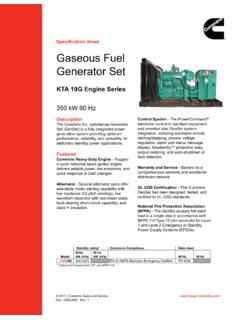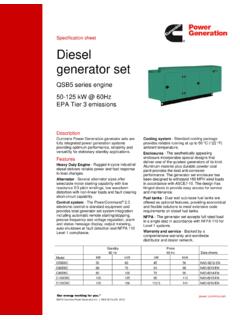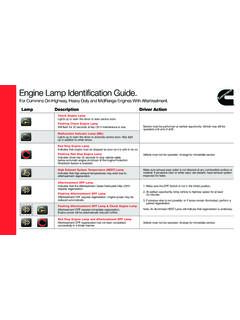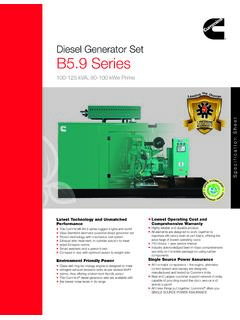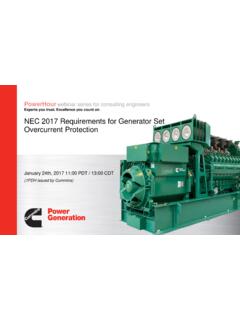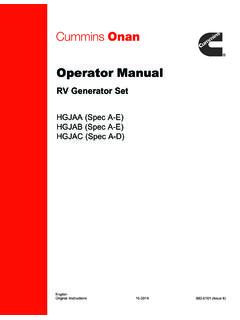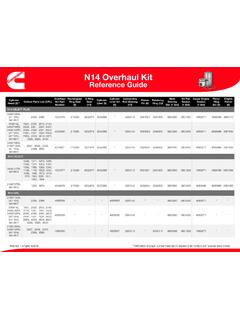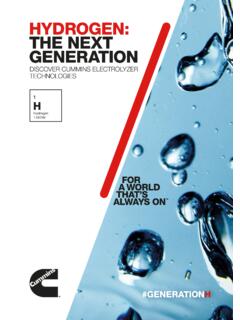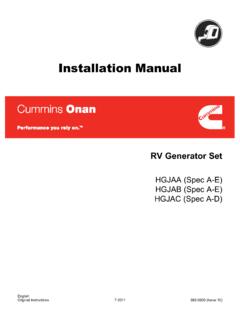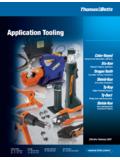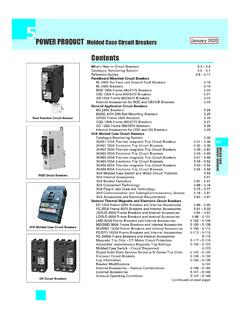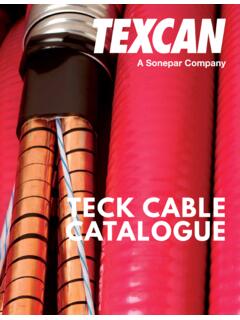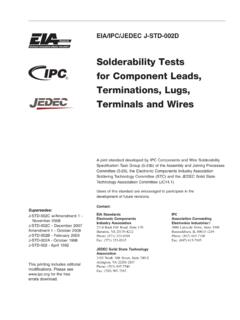Transcription of Transfer Switches Made Easy: A Guide for Selecting ...
1 November 20th, 2019 11:00 PDT / 13:00 CDT(1 PDH issued by Cummins) Transfer Switches Made Easy: A Guide for Selecting Transfer SwitchesPowerHourwebinar series for consulting engineersExperts you trust. Excellence you count !PowerHour is designed to help our engineer partners Keep up to date on products, technology, and codes and standards development Interact with Cummins experts and gain access to ongoing technical support Participate at your convenience, live or on-demand Earn Professional Development Hours (PDH)Technical tips: Audio is available through teleconference, or your computer (don t forget to unmute) You are in listen only mode throughout the event Use the WebEx Q&A Panelto submit questions, comments, and feedback throughout the event. We will provide sufficient Q&A time after presentation If you lose audio, get disconnected, or experience a poor connection, please disconnect and reconnect Report technical issues using the WebEx Q&A Panel, or email your panelistsMunir Kaderbhai,Product Manager, Transfer SwitchCummins presenter:Cummins facilitator:Tom Bakritzes, Global Sales Training ManagerCummins local Cummins contacts: Western Canada: Ian Lindquist Western Canada Region Eastern Canada: Melvin Nicholas Eastern Canada Region AZ, ID, NM, NV: Carl Knapp Rocky Mountain Region CO, MT, ND, UT, WY: Chris Scott Rocky Mountain Region Northern IL, IA: John Kilinskis Central Region UP of MI, MN, East ND, WI: Michael Munson Central Region NE, SD, West MO, KS: Earnest Glaser Central Region South IL, East MO: Jeff Yates Central Region TX, OK, AR, LA, MS, AL, Western TN: Scott Thomas Gulf Region FL, GA, NC, SC, Eastern TN: Robert Kelly South Region NY, NJ, CT, PA, MD.
2 Charles Attisani East Region CA, HI: Brian E Pumphrey Pacific Region WA, OR, AK: Tom Tomlinson Pacific Region For other states and territories, visit views and opinions expressed in this course shall not be considered the official position of any regulatory organization and shall not be considered to be, nor be relied upon as, a Formal Interpretation. Participants are encouraged to refer to the entire text of all referenced documents. In addition, when it doubt, reach out to the Authority Having Confidential5 Course Objectives:A Guide for Selecting Transfer switchesAfter completing this course, participants will be able to: Understand the different variants of UL1008 Transfer Switches and know when to use them Have a list of basic selection criteria and step-by-step Guide to help them with their Transfer switch selection process Have a better understanding of some of the common pitfalls in ATS selection process and how to avoid System Building BlocksParalleling Generator SetsSwitchgearTransfer SwitchesGridLoadsDigital MasterDigital Cloud Solutions7 What is a Transfer Switch?
3 Monitors the availability and quality of two connect power sources Transfers power consumed by electrical loads connected to the Transfer switch output between two sources based on source availabilityGenerator OCPDU tility OCPD/Service DisconnectLoadOvercurrent Protection DeviceG8 Key Considerations When Selecting a Transfer Switch Switch type Transition type Application Grounding schemes Cable sizes and entry requirements Enclosures Voltage Current Fault current Selective coordination Type of load in the systems per Codes & Standards9 Different Types of Transfer SwitchesLoadAutomatic Transfer SwitchGController10 Different Types of Transfer SwitchesGenerator OCPDLoadNon-Automatic Transfer SwitchGElectrical Switch(Local or remote actuation)LoadAutomatic Transfer SwitchGController11 Different Types of Transfer SwitchesGenerator OCPDLoadNon-Automatic Transfer SwitchGGenerator OCPDLoadManual Transfer SwitchGElectrical Switch(Local or remote actuation)Manual Handle(Local actuation only)
4 LoadAutomatic Transfer SwitchGController12 Different Types of Transfer SwitchesGenerator OCPDI ntegratedService DisconnectLoadService Entrance Rated Transfer SwitchATSG13 Different Types of Transfer SwitchesLoad>>>>>>Bypass Isolation Transfer SwitchMTSATSGG enerator OCPDI ntegratedService DisconnectLoadService Entrance Rated Transfer SwitchATSG14 Transfer Switch ApplicationLoadUtility to GeneratorFor facilities with a standby power systemand a single utility feedG15 Transfer Switch ApplicationLoadUtility to GeneratorFor facilities with a standby power systemand a single utility feedUtility to UtilityFor use in facilities with redundant feedsbut no standby generatorLoadG16 Transfer Switch ApplicationLoadLoadUtility to GeneratorFor facilities with a standby power systemand a single utility feedUtility to UtilityFor use in facilities with redundant feedsbut no standby generatorGenerator to GeneratorFor facilities with a prime power systemusing multiple on-site generatorsLoadGGG17 Transition TypesThere are two ways to transition the loads:Closed TransitionOpen Transition Make before break transferWatch out: -Safeguards and extensive documentation required by utility may add cost and complexityDelayed TransitionIn-Phase Transition Adjustable neutral position delay Flexible, simple, reliable Best option for large motors Step loading generators possible Based on synchronization of sources Fast typically 30ms 50ms delay Okay for resistive loads and small inducive Break before make transferWatch out: -Inductive load residual voltage decay rates18 Two Position vs.
5 Three Position SwitchesGenerator OCPDU tility OCPD/Service DisconnectLoadGenerator OCPDU tility OCPD/Service Disconnect2 Position Double Throw 3 Position Neutral Position Delay Good choice for Switches requiring: Delayed Transition Load shed won t Transfer to dead sourceGG19 Concept CheckWhich transition types are not suitable for stored energy loads (large motors, MRIs)?a)Open (In Phase) b)Open (Delayed)c)Closed d)Both b) and c)20 Concept CheckWhich transition types are not suitable for stored energy loads (large motors, MRIs)?a)Open (In Phase) b)Open (Delayed)c)Closed d)Both b) and c)21 Lets Get Grounded on 3 Pole vs. 4 Pole Choice depends on grounding scheme of the system NFPA70 (NEC) requires some systems to have ground fault protection (GFP) Complications and errors less likely by using 4 pole Transfer switches22 Enclosure Types and Selection CriteriaNEMAType 1 NEMAType 3 RNEMAType 4 NEMAType 4 XNEMAType 12 Dust Light/Indirect SplashingIngress of solid foreign objects (Dust, fibers, etc.
6 Falling rain & ice formationNot rain-tightNot water-tightNot dust-tightKnockout freeWeather tight (weatherproof)Type 4 +corrosion resistanceStainless steel is bestChoice based on: (1) Placement, (2) Environmental conditionsIndoorOutdoor23 Cable Size and Entry Requirements Detailed information is typically provided in Transfer switch specification sheets and/or outline drawings Information to look for: Cable entry Lug options and capacities Mechanical lugs or Compression lugs may be available 90 C rated and accept copper or aluminum wire Example: Snapshot of Cummins OTPCC ATS Outline Drawing Type 1 Enclosure24 Voltage Selection Transfer Switches designed to have two unsynchronized power sources connected to it A well designed UL Transfer switch will provide adequate spacing and insulation to cope with the increased voltage stress. Typical AC Voltages: 120, 208, 240, 480, 600 volts, single or three phase, 50/60Hz25 Current Rating Selection Switches are rated for continuous current hold maximum value for three hours or more.
7 Typically capable of carrying 100% of the rated current at an ambient temperature of 40 C Typically, the most commonly used ampere ratings range from 40 to 4000 amperes. Switch frame size will dictate the current rating range and WCR Ratings Service Entrance Rated Transfer Switches may be rated at 80% Anticipate future load requirements during the planning process - select a Transfer switch with a continuous current rating equal to the total of the anticipated load26 Overcurrent Protection OCPDOCPD A fault downstream of the Transfer switch will result in a short circuit current flowing through the Transfer switch High level of fault currents will cause the following stresses on the Transfer switch: Thermal Magnetic Transfer switch mustbe provided with overcurrent protection devices (OCPD) on both sources Available fault current needs to be determined Withstand and close rating of the Transfer switch must matched to the available fault currentShort circuitG27 Selective Coordination Challenges from ATS PerspectiveGenerator OCPDS elective Coordination is required for emergency, legally required standby and critical operations power systems circuits NEC-2017, , , and.
8 Over-current devices shall be selectively Selective coordination will require time delays to be set on OCPDs In the example shown, A musttrip after B Time delay on A Time delay setting of OCPD A will depend on the available fault current from either source & the device B trip curve characteristic For the duration of the OCPD A time delay, the ATS must be able to: Withstand the fault Close into the fault Transfer Switches manufacturer will publish a Withstand and Close ratingABShort circuitNormal OCPDG28UL 1008 Short Circuit Ratings UL 1008 requires all ATS to have a withstand and closing rating (WCR) Rating can either be time based or specific OCPD (breaker/fuse) based OCPD based ratings allow for higher WCR ratings but requires the ATS to be protected by a listed breaker or fuse Allowing for either time based or specific breaker based ratings enables flexibility for a cost effective designFuse/Current Limiting breakerBreaker RatingTime Duration Rating( 3cycle)Short time Rating( cycle)
9 Increase in trip timeOCPD devices allowed are Listed by Transfer switch manufacturerEase of Selective CoordinationDecrease in WCR rating29 ATS Short Circuit RatingsSeveral Short Circuit Ratings are available at each amp nodeSpecific overcurrent device ratings are substantially higher than time based ratings As high as 200,000 amps with current limiting breakers and fusesMax Fuse, Size and type480600240480600240480600240480600 OTEC, OTPCB TPC600 A Class J, RK1, RK5 or 1200 A Class L, T200,000200,000125,000100,00050,000200,0 00200,000200,000 OHPC, CHPC400 A Class J or T or 200 A Class RK1 or 100 A ClassrK5200,000200,000200,000200,000200, ,00025,00018, ,000 OTEC, OTPCB TPC600 A Class J, RK1, RK 5 or 1200 A Class L, T200,000200,000125,000100,00050,000200,0 00200,000200, ,00025,00025,000 OHPC, CHPC400 A Class J or T or 200 A Class RK1 or 100 A ClassrK5200,000200,000125,000100,00050,0 00200,000200,000200, ,00035,00022, ,000 WCR @ 480V260300 Time Based RatingsShort Time RatingsWCR @ V oltsWCR @ V oltsWCR @ V oltsTime (sec)WCR @ V oltsTime (sec)A mp sATS ModelBypass ModelFuse protectionSpecif ic Breaker Protection (Common)Specif ic Breaker Protection (General)31UL1008 Listing and OperationEmergency, Legally Required, Critical Operation Power (NFPA70 700/701/708) Require UL1008 WPWR - Automatic Transfer Switches for Use in Emergency Systems Automatic or Bypass Isolation Manual/Non-Automatic not permittedOptional Standby (NFPA70 702) Requires UL1008 WPXT- Automatic Transfer Switches for Use in Optional Standby Systems Automatic or bypass isolation Manual/Non-Automatic permitted Healthcare (NFPA70 517/NFPA99/OSHPD) Require UL1008 WPWR - Automatic Transfer Switches for Use in Emergency Systems Automatic or Bypass Isolation While not specifically required by code in all jurisdictions, it may be advantageous to ensure ATSs are equipped with bypass/isolation capabilities.
10 Health care facilities in California, governed byOffice of Statewide Health Planning and Development(OSHPD) mandate the use of Bypass Isolation Switches in certain systems32 Concept CheckNon-automatic Transfer Switches are permitted for Emergency Systems, True or Falsea)Trueb)False33 Concept CheckNon-automatic Transfer Switches are permitted for Emergency Systems, True or False?a)Trueb)False34 Example of Typical SystemReference NFPA 110 Standard for Emergency and Standby Power Systems 2019 FIGURE (a) Typical Rotating Emergency Power Supply Parameters ATS SpecificationEPSS 1 Healthcare Emergency SystemEnvironmentally controlled, indoor installationNFPA110 1 sec time delay requiredVoltage 277/480V, 3 Phase, 60 HzService disconnect is available upstreamGFP is requiredConsists of HVAC loadLoad current 450 AAvailable fault current 35,000 AmpsSelective coordination is required with downstream MCCB breakerSwitch Type Bypass IsolationUL1008 Listing - Emergency SystemApplication Utility to GeneratorTransition Type Open transition, delayedVoltage 277/480V, 3 Phase, 60 HzCurrent Rating 600A 4 Pole ATSNEMA Type 1 EnclosureScenarioSpecification36 Match Available Fault Current to Transfer Switch WCR RatingsAvailable fault current < Selected WCR Rating?

